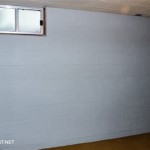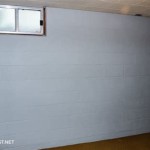How to Make a Concrete Basement Floor Look Nice
Concrete basement floors are often viewed as cold, damp, and uninviting. However, with a bit of effort and creativity, they can be transformed into attractive and functional spaces. Numerous options exist for finishing concrete, allowing homeowners to customize their basements to complement their personal style and needs.
Preparing the Concrete Surface
Before applying any finish, proper surface preparation is crucial for long-lasting results. This ensures good adhesion and a smooth, even surface.
- Cleaning: Thoroughly clean the concrete floor to remove dirt, dust, grease, and any existing coatings. Use a degreaser for oil stains and a stiff-bristled brush for stubborn grime. A pressure washer can be beneficial for large areas.
- Repairing Cracks: Address any cracks or imperfections in the concrete. Use a concrete patching compound specifically designed for floors, following the manufacturer's instructions. Allow ample drying time before proceeding.
- Leveling: If the floor is uneven, consider using a self-leveling concrete compound to create a smooth surface. This is especially important for certain flooring options like epoxy coatings or tile.
- Moisture Mitigation: Basements are prone to moisture. Applying a concrete sealer or moisture barrier can prevent issues with dampness and mold growth affecting the chosen finish.
Painting the Concrete Floor
Painting is a cost-effective and relatively simple way to enhance the appearance of a concrete basement floor. It offers a wide range of color choices.
- Primer: Apply a concrete primer designed for good adhesion and stain blocking. This will ensure the paint adheres properly and provides a uniform finish.
- Paint Application: Use a concrete floor paint that is durable and resistant to moisture and abrasion. Apply multiple thin coats, allowing each coat to dry completely before applying the next. Consider using a roller designed for concrete floors for even coverage.
- Sealer (Optional): Apply a concrete sealer to protect the paint and enhance its durability, especially in high-traffic areas.
Epoxy Coatings
Epoxy coatings provide a durable, glossy, and stain-resistant finish. They are ideal for basements prone to moisture or heavy use.
- Surface Preparation: Ensure the concrete surface is properly prepared and etched according to the epoxy manufacturer's instructions. This step is critical for proper adhesion.
- Mixing and Application: Carefully mix the epoxy components according to the manufacturer's instructions. Apply the epoxy in thin, even coats using a roller or squeegee designed for epoxy applications.
- Optional Decorative Flakes: Decorative flakes can be added to the epoxy to create a unique and visually appealing finish. Broadcast the flakes evenly over the wet epoxy.
- Topcoat (Optional): A clear topcoat can be applied to enhance the gloss and durability of the epoxy finish.
Concrete Staining
Concrete staining provides a unique, marbled look that enhances the natural beauty of the concrete.
- Stain Selection: Choose an acid-based or water-based concrete stain based on the desired look and level of permanence. Acid stains react chemically with the concrete to create a mottled effect, while water-based stains offer a wider range of colors and are less corrosive.
- Application: Apply the stain according to the manufacturer's instructions, using a sprayer, brush, or roller. Multiple coats can be applied to achieve the desired color intensity.
- Neutralization: After the stain has dried, neutralize the surface to stop the chemical reaction (for acid stains) and remove any residue.
- Sealer: Apply a concrete sealer to protect the stain and enhance its longevity.
Installing Flooring Over Concrete
Various flooring options can be installed directly over concrete, providing additional insulation and aesthetic appeal.
- Subfloor: Consider installing a subfloor for added insulation, moisture protection, and to create a more comfortable surface underfoot. Options include rigid foam insulation or engineered wood subflooring.
- Flooring Options: Choose from a variety of flooring materials such as laminate, vinyl, engineered wood, or carpet tiles. Ensure the chosen flooring is suitable for basement environments.
- Installation: Follow the manufacturer’s instructions carefully for installing the chosen flooring material. Ensure the concrete surface is clean, level, and dry before installation.
Adding Area Rugs
Area rugs are an easy and affordable way to add warmth, color, and style to a concrete basement floor. They can also help define different areas within the space.
- Rug Selection: Choose rugs that are durable and easy to clean, especially in high-traffic areas. Consider materials like polypropylene or wool blends.
- Rug Pad: Use a rug pad underneath the area rug to provide cushioning, prevent slipping, and protect the concrete floor from scratches.
Improving Basement Lighting
Proper lighting can significantly impact the overall ambiance of a basement. Improving lighting can make the space feel more welcoming and spacious.
- Ambient Lighting: Install recessed lighting, track lighting, or pendant lights to provide overall illumination.
- Task Lighting: Incorporate task lighting in specific areas, such as workbenches or reading nooks, to provide focused illumination.
- Accent Lighting: Use accent lighting to highlight architectural features or decorative elements.

15 Diy Basement Flooring Ideas Affordable Options For Basements

Diy Basement Floor Stain And Finish 2 Colors Without Etching Youtube

Diy Concrete Floor Cheap Home Diys Design Mom

Polished Concrete Flooring Options For Your Basement Duraamen

How To Make Concrete Look Like Marble Floors Network

How To Paint A Concrete Floor Southern Hospitality

How To Paint A Concrete Floor In Basement Twofeetfirst

Basement Floor Paint Options Hgtv

Stained Concrete Basement Floor Ideas

A Guide To Stained Concrete Basement Floors
See Also








